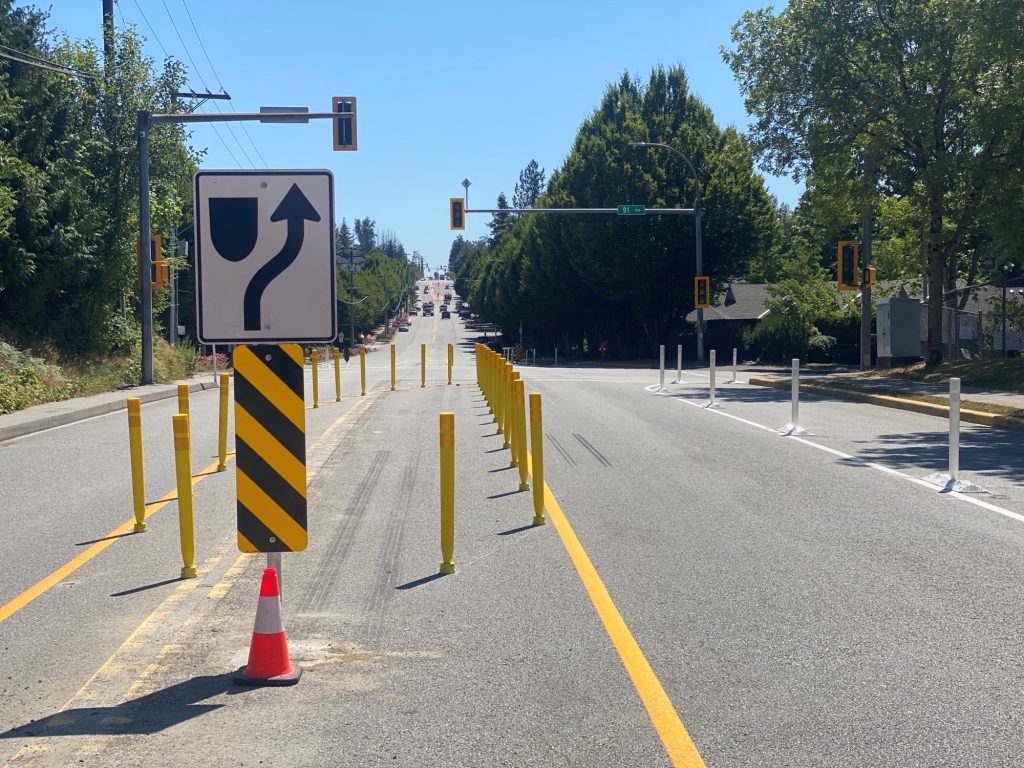Written by Heidi Roukema, 12/13/2023

Have you ever heard of the term road diet? Neither had I until the Township of Langley reached out to us this past summer. Road diets have been around since the 1980’s. Their now trending popularity is due to the current demand for climate change action.
What is a Road Diet?
A road diet was a transportation term coined by Dan Burden and Peter Lagerway in 1999. It refers to the narrowing of an existing road to create usable space for other purposes. Dan and Peter’s report Road Diets: Fixing the Big Road, showed how slimming down distended roads could affect transportation. Here are some challenges that multi-lane roads were presenting:
- Rear end crashes from speeding vehicles and lane switching
- T-bone crashes from vehicles attempting to cross from side streets
- Cyclist accidents due to narrow road shoulders
- Pedestrian accidents due to a lack of crosswalk visibility
According to the study’s results, removing lanes would increase traffic safety and mobility. Some of the biggest benefits were:
- Traffic calming to reduce speeds and crashes
- Increased traffic flow with the incorporation of a center turn lane
- Creating additional space to protect cyclists
- Enhanced visibility with reduced crosswalk distances
Road Diets Help Solve Climate Change
Road diets support green initiatives and active transportation networks. Freed-up road space leaves room for:
- Widening sidewalks
- Incorporating bike lanes
- Adding curb extensions for street parking and transit stops
- Median landscapes
Active transportation is using self power to get to your destination. Forms of transportation include walking, running, cycling, electric bikes and scooters. Active transportation programs are a component of the B.C. government’s efforts to lower greenhouse gas emissions.
By 2030, the B.C. government wants public transit and active transportation to account for 30% of all the trips taken within the province. To meet or exceed these goals, they are providing cost share funding to help B.C. Communities adopt similar measures.
A Win-Win for Langley Infrastructure and the Environment
The Township of Langley contacted us because they wanted to calm traffic on a busy road in Walnut Grove. The street is part of Translink’s Major Road Network and currently designated as a truck route. There are two elementary schools on the road so the safety of children walking to school was a concern.
The street was initially built wider to accommodate extra lanes as per the Township’s Master Transportation Plan. Standard traffic calming measures can not be applied because it is a major arterial road. To help determine ways to resolve the issues, the Township conducted a corridor study.
The corridor study found that the extra lanes were not necessary. The Township then purchased Shur-tite® delineator posts from us. They slimmed down the road with the posts, guiding traffic away from the sidewalk. The posts also act as a deterrent for motorists trying to pass. In the future, the Township plans to use the extra space for street parking and protected bike lanes.
The modifications also help Langley Township fulfill its commitment to addressing climate change. Their pledge is to reduce human-caused greenhouse gas emissions by 45% by 2030.
Road Diet Myths
While road diets have their benefits, they are not without controversy. A common myth is that road diets cause traffic congestion because of the reduction in road lanes. As noted in the Road Diet report, there are no significant changes in traffic volume before and after the road diet. In most cases, volumes actually increased.
Road diets discourage non-local traffic from using local roads. This creates a new problem of vehicles diverting onto residential side streets. According to the Federal Highway Administration, this thinking is not warranted. Many roads have more travel lanes than necessary. Road Diets are meant for streets that have excess capacity. They are not recommended for roadways with daily average traffic volumes exceeding 25,000.
Road diets work. Are you concerned about the traffic safety in your neighborhood? If so, think about having your road put on a diet.
